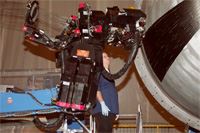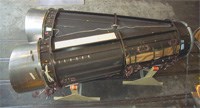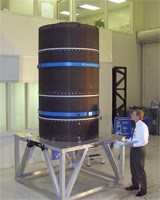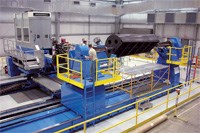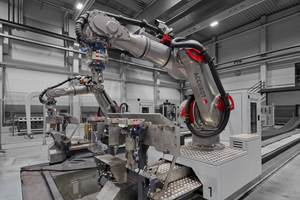Fiber Placement The Centerpiece Of NCAM
Cryogenic composites just one facet of Lockheed Martins National Center for Advanced Manufacturing.
Automated fiber placement has taken a giant leap in Louisiana, thanks to a rare partnership of industry, academia and government that has created the National Center for Advanced Manufacturing (NCAM), located in New Orleans, La., U.S.A. The center, formed through a collaboration of Lockheed Martin Space Systems - Michoud Operations, NASA, the State of Louisiana and the University of New Orleans (UNO) in 1999, features a state-of-the-art Ingersoll Machine Tools Inc. (Rockford, Ill., U.S.A., now owned by Italian firm Camozzi) machine with enhanced capabilities, designed for fast, automated processing of large structures. In an effort to expand advanced composite manufacturing technologies, NCAM has brought together advanced manufacturing equipment and engineering and research skills.
NCAM's home is NASA's Michoud Assembly Facility (MAF), the manufacturing site for the Space Shuttle's external fuel tanks since 1973. MAF is an 832-acre complex supporting multiple production and testing activities, and includes a deepwater port for shipping very large structures. NCAM's manufacturing facilities and offices, which house designers, engineers, classrooms and testing laboratories, occupy 120,000 ft2 of the largest MAF structure, a 42-acre, environmentally controlled production building.
"With our equipment and supporting engineering force, we can design, test and certify and then cost-effectively produce virtually any composite structure or assembly," says Jeff Corbin, director of business development at Michoud Operations. "The collaboration that we've developed for end-to-end service is critical for competitiveness in today's economy."
HPC recently had the opportunity to learn more about the NCAM facility and its capabilities for aerospace programs.
Cryogenic expertise
NCAM has targeted two key manufacturing processes for further development and promotion: fiber placement of high-performance composites and metallic friction stir welding for metallic assemblies, a welding method that "stirs" the metal into a plastic state. The fiber placement machine is a 7-axis, 24-tow CNC device capable of fabricating composite parts up to 4.9m/16 ft in diameter and 12.3m/40 ft long. Because of Lockheed Martin's Space Shuttle history, an obvious target market is the development of composite tank structures and ancillary equipment designed to contain cryogenic (i.e., very low temperature) fuels on space launch vehicles.
By way of background, Lockheed Martin Space Systems has worked for decades to adapt composites for cryogenic applications, a difficult task. While the materials are attractive because of the 20 to 40 percent weight savings that they offer over metallic structures, leakage of the fuel through the laminate as well as chemical compatibility are big issues. For example, to contain liquid oxygen (LOX) or liquid hydrogen, the composite must be effectively defect-free, to eliminate any interconnecting porosity, microscopic delaminations or microcracks between resin and fibers. Micro-cracks can occur because of the large differential in the coefficient of thermal expansion (CTE) between resin and fibers in the laminate when the composite is cooled to very low temperatures, typically -230°C/-423°F for liquid hydrogen and -183°C/-297°F for liquid oxygen, during thermal cycling. The differential causes significant internal tensile stresses that can lead to cracks in the matrix. In addition, the tank has to endure structural loads that include boost acceleration, aerodynamic loading and induced vibro-acoustic loads from the engines, as well as pressure loads needed to drive the propellant into the feedline system.
Lockheed Martin engineers tackled the challenge to develop a LOX-compatible composite material over the past several years, and produced an unlined composite LOX tank for the X-34 suborbital test vehicle, which met performance-based requirements for impact (see HPC July/August 2000, p. 52). As a result of that work, the group patented a proprietary unidirectional carbon fiber/toughened epoxy prepreg tape for use in producing cryogenic parts.
Automated manufacturing
improves performance
Fiber placement played a key role in producing the cryogenic containment structures, says Corbin, because of the precision that's achievable with the automated process. "The ability to accurately and precisely place the fibers consistently, ply after ply, keeps the manufacturing defects and voids to an extreme minimum," he states. "That's why developing a facility with fiber placement equipment was such a high priority for us."
The previous cryogenic projects, such as the X-34 tank, ancillary feed lines and coverplates, were completed with NASA's smaller fiber placement machine, located in Huntsville, Ala., U.S.A., along with some hand layup. With the new facility and the vastly improved Ingersoll machine in place, totally automated cryogenic part manufacturing is now possible in-house.
The machine operates by numerically translating computer-based designs into fiber path geometry via Ingersoll's Composite Programming Software (CPS), which controls the machine's fiber placement head. The system uses a numerically controlled robotic "arm" terminating in a "head," capable of seven axes of motion during layup, including arm crossfeed (x-axis), arm tilt (e and j axes), carriage longitudinal movement (z-axis), part/mandrel rotation (c-axis), as well as placement head "yaw" and roll.
The head, the key to the entire system, draws up to 24 multiple fiber tows under tension and simultaneously steers and compacts them to a particular orientation and ply buildup pattern, then cuts them. The Ingersoll head can place either carbon towpreg or 1/8-inch slit prepreg tape and has the ability to collimate (or line up) as well as ensure the straightness of either type of fiber material. Slit tape (made with Lockheed's patented resin formula) is purchased from Cytec Engineered Materials Inc. (Tempe, Ariz., U.S.A.). If all 24 spools are loaded with slit tape, the machine can lay a maximum 3-inch wide course on a tool.
The 24 12-inch diameter spools, which are larger than the 8-inch industry standard (so more material can be processed before reloading), are housed in a temperature-controlled creel house atop the machine. The spools and tensioners are refrigerated to about 4°C/40°F to ensure that the prepreg tack is kept to a minimum. Low tack facilitates material feed through the head's feed system and maximizes material "out time" from the freezer where it's stored prior to use. Each tow/tape has its own individual feed, mechanical knife cutter and clamping mechanism. The machine has the capability to make straight, edge-of-ply or change-of-path angle cuts to ensure precise fiber laydown patterns. Fiber can be placed at a rate of up to 1,200 inches per minute (ipm) on simple part segments without buildups and 250 ipm in areas where tows are cut or added for buildups.
For a cryogenic part like the demonstration tanks made to date, tape alignment during laydown is critical for leakage control, says Lockheed Martin's David Achary, one of the facility's lead composites engineers. Joints between tapes are precisely butted, and never overlapped. The head's programmable compaction roller can apply any pressure up to a maximum of 400 psi, which consolidates the layup. To ensure good adhesion, the prepreg is heated via a stream of hot nitrogen at the nip point. Lockheed's Charlie Gudaitis, who helped customize the machine's capabilities, says that nitrogen is preferred over hot air because it is "extremely clean and dry" and doesn't incorporate any moisture into the laminate, which might occur if hot air is used.
A unique feature of the NCAM machine's nitrogen system is its ability to heat prepreg to 232°C/450°F, allowing the use of high-temperature resin systems, such as bismaleimide (BMI) and polyimides, which can't be processed on some other automated equipment. Lockheed Martin has successfully produced several noncryogenic aerospace demonstration articles to date using the high-temperature process. In addition, experiments are underway on a new high-temperature fabrication option that Lockheed terms in situ fiber placement. With high heat and pressure, the material is consolidated to a final "net" thickness prior to cure. "Our tests have shown that being able to apply the material at net thickness during layup allows us to eliminate vacuum debulks and fiber wrinkling in thick structures with tight radii," says Corbin. "Ultimately this allows us to eliminate the autoclave, which improves cost efficiency for very large structures," he says. The results of this work will be reported later in 2004, once development has progressed further, according to Corbin.
While fiber placement traditionally has been considered practical only for very large part production, Gudaitis points to the speed of the machine as a means for improving efficiency for both large and small parts. "The cut and add rates are very fast," says Gudaitis. "This significantly increases productivity for parts where small, complicated buildups are needed." Ingersoll's Dan Jarvi points out that the machine is bi-directional, able to cut and add on the fly in either direction, that is, on the outbound as well as the return path.
Another feature that sets the NCAM equipment apart, explains Gudaitis, is the ability of the machine's CPS control software to drop or add any of the 24 tows at any point in the fabrication process. This enables tows to be placed in a specific pattern, which he calls a "basketweave" process. "We can add and drop tows at any time. This enables a designer to begin a course with all tows and then drop a pattern of tows in an area of reduced loads," explains Gudaitis. "On subsequent plies the missing tows are filled in, almost like a weaving process." This effectively interleafs all the plies while allowing the designer to vary ply density anywhere on the part. The interleafing is a benefit for structural parts such as airframe skins, says Gudaitis, since ply configurations can be specifically tailored depending on part requirements, for a lighter part with the same strength properties. Also, peel loads are significantly reduced, since laminate buildups aren't stacked on top of each other in layers that can be peeled away.
Perhaps the most important capability that the machine enables is the ability to fabricate the cylindrical body and one domed end of a tank in a single integrated operation. Corbin explains that prior to acquisition of the Ingersoll machine, both domed ends of cryogenic tank articles had to be hand layed up, then adhesively bonded and cocured with the tank "barrel" sections, a procedure that added complexity and some leakage risk, particularly where the domes curved into tight radii to join the barrel section. The Ingersoll machine system includes a cantilevered headstock (the mandrel attachment point), meaning the tool or mandrel doesn't have to be supported by a second (tailstock) attachment, leaving the tool free. This enables the head to maneuver completely around the end of the tool. Says Jarvi, "The ability of the head to walk completely around the headstock took some software reprogramming but we were able to successfully solve it."
NCAM is currently investigating whether program requirements warrant the purchase of a second fiber placement machine, one with a smaller 20-ft by 8-ft work envelope.
Supporting capabilities
Michoud Operation's composites design group includes 26 aerospace engineers with expertise in two- and three-dimensional modeling, finite element and finite difference modeling, structural design, microstructural materials analysis and system integration. Computer software support includes NASTRAN finite element modeling, FiberSIM (supplied by VISTAGY Inc., Waltham, Mass., U.S.A.) and CATIA 5.0, from Dassault Systemes (Woodland Hills, Calif., U.S.A.). "Our design team can provide rapid and accurate definitions of structural shapes, associated loads, environments, stresses, reactions and simulated performance," notes Corbin.
An important part of NCAM's cryogenic applications has been testing. NCAM has a laboratory facility for large-scale liquid oxygen compatibility testing, unique in the industry. In addition, materials testing can be conducted on coupon specimens up to full-scale structures. Real-time and accelerated environmental simulations can be conducted from -253°C to 538°C (-423°F to 1000°F), with the ability to control numerous parameters, ranging from pressure (to simulate the vacuum of space) to UV radiation.
Manufacturing is supported by a number of autoclaves and ovens. The facility also is fully equipped for part finishing and nondestructive inspection. Equipment includes a Forest Line (Capdenac, France) 5-axis, high-speed machining center with a 7m by 3.4m by 1.5m (23-ft by 11-ft by 5-ft) work envelope, for finishing of both composite and metallic parts. A Matec Instrument Co. Inc. (Northborough, Mass., U.S.A.) 10-axis universal nondestructive evaluation (NDE) system is on order, which together with the existing Metronor (Nesbru, Norway) portable dimensional inspection system provides the tools for post-production inspection of parts of any dimension. Other key equipment includes a laser projection system and a Gerber Technology (Tolland, Conn., U.S.A.) computer-controlled broadgoods cutting table.
Finally, perhaps one of the most vital missions for NCAM is its role as a manufacturing "laboratory" for university students and researchers. NASA is providing funds for a consortium of universities, led by UNO's College of Engineering, which is conducting research and educational programs on advanced materials and the applicability of advanced manufacturing technologies. In addition to UNO, members include Virginia Tech, Mississippi State University, Texas A&M, Louisiana State University and Tennessee Technological Institute. The group is tackling a wide range of research subjects. Notable among the many goals are lower-cost, non-autoclave manufacture of large, reusable aerospace structures, further development of E-beam processing and a more complete understanding of the forces and conditions that influence microcrack growth and the service life of composites.
"We're a unique collaboration, one that we think is necessary to compete in today's global composites industry," concludes Corbin. "We've got multiple strengths — we can train a workforce, conduct R&D and carry out large-scale structure production, abilities that we hope will position us for the future."
Related Content
Automated robotic NDT enhances capabilities for composites
Kineco Kaman Composites India uses a bespoke Fill Accubot ultrasonic testing system to boost inspection efficiency and productivity.
Read MoreLaser NDT, DIC systems demonstrate optimized noncontact composites inspection
CAMX 2024: Dantec Dynamics is presenting three of its laser shearography NDT and DIC devices, geared toward reliable measurement results.
Read MorePlant tour: Airbus, Illescas, Spain
Airbus’ Illescas facility, featuring highly automated composites processes for the A350 lower wing cover and one-piece Section 19 fuselage barrels, works toward production ramp-ups and next-generation aircraft.
Read MoreVIDEO: AI, cameras and lasers for FOD detection
Virtek Vision demonstrates its Iris AI technology at CAMX 2024. It combines laser projection with machine learning software to detect foreign object debris during a composite layup.
Read MoreRead Next
“Structured air” TPS safeguards composite structures
Powered by an 85% air/15% pure polyimide aerogel, Blueshift’s novel material system protects structures during transient thermal events from -200°C to beyond 2400°C for rockets, battery boxes and more.
Read MorePlant tour: Daher Shap’in TechCenter and composites production plant, Saint-Aignan-de-Grandlieu, France
Co-located R&D and production advance OOA thermosets, thermoplastics, welding, recycling and digital technologies for faster processing and certification of lighter, more sustainable composites.
Read MoreDeveloping bonded composite repair for ships, offshore units
Bureau Veritas and industry partners issue guidelines and pave the way for certification via StrengthBond Offshore project.
Read More




